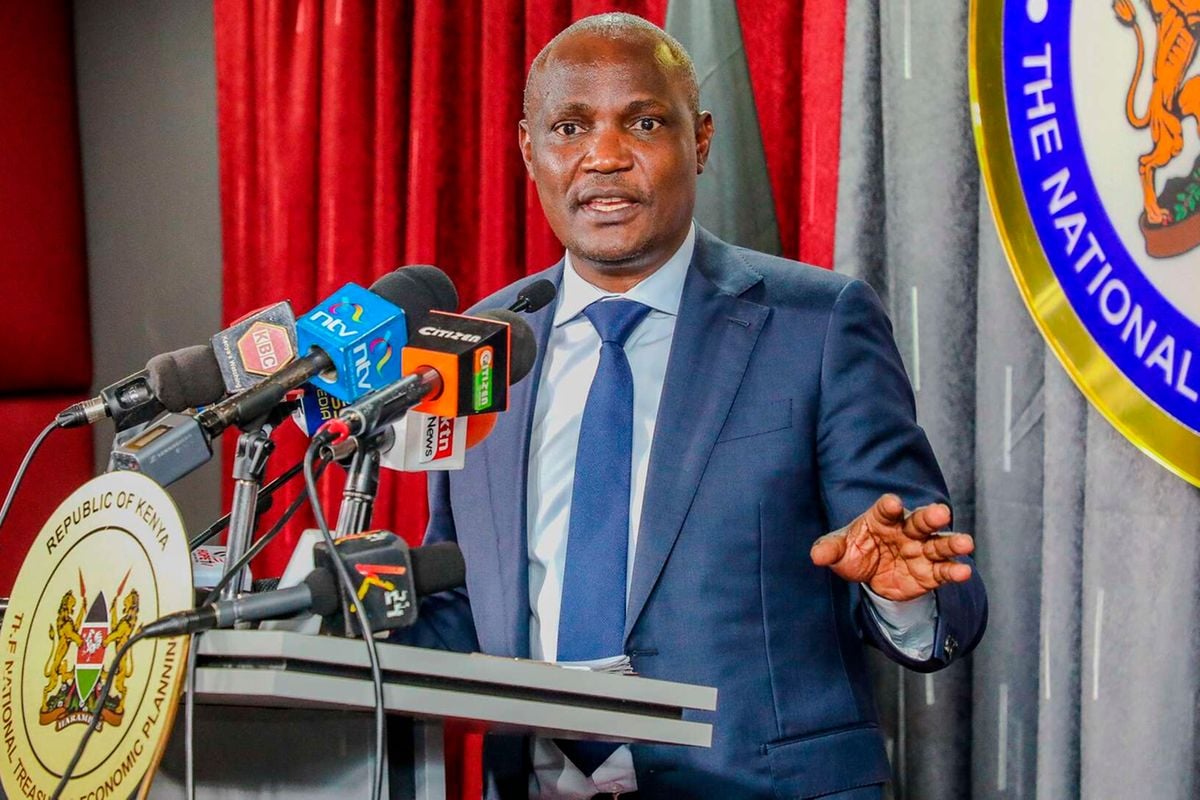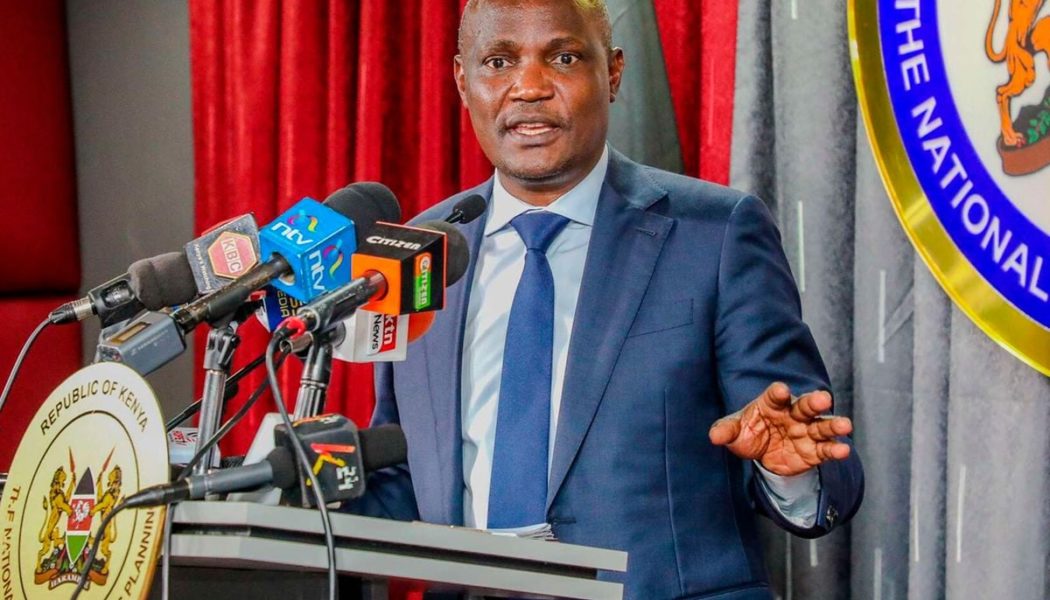
Treasury Cabinet Secretary John Mbadi is working under very precarious circumstances.
As he burns the midnight oil seeking to streamline Kenya’s fiscal landscape, it must not be lost on him that any reference to the rejected Finance Bill 2024/2025 might reignite the ire of the Gen-Zs who frustrated its implementation in June this year.
Yet, the country cannot afford to continue in a situation where more than 10 percent of its national budget is financed from external sources.
Such a situation not only erodes the country’s sovereignty and national pride, but also undermines development, as a good chunk of the domestic revenue is used to repay offshore debts.
Currently, Kenya utilises more than Sh6 out of Sh10 of exchequer revenues to repay its debts, leaving a paltry Sh4 or less for development and recurrent expenditures. This is unsustainable.
No wonder, therefore, the country is struggling to meet its domestic obligations. Counties are running on very slim budgets as university students, programmes and tutors go without funding for several months. The story is the same in many other sectors across the public service. This is shameful for the country.
Fiscal indiscipline
Sadly, this phenomenon of a cash-strapped economy did not start with the President William Ruto’s administration. Kenya has been teetering on the verge of default on its international debt obligations for about a decade now.
This unfortunate situation was visited upon the country through fiscal indiscipline under the Uhuru Kenyatta administration.
The government maintained huge deficits in its budget cycles to finance ambitious infrastructure development projects. Pundits assert that these infrastructure projects were huge conduits for corruption through opaque procurement processes.
An estimated 30 percent of the budget was lost to malfeasance, according to former President Kenyatta, who painfully lamented that corrupt public officials pocketed at least Sh2 billion per day in underhand dealings.
Budgeted corruption during the Uhuru administration was, therefore, responsible for widening the budget deficits that returned the country to the stranglehold of the World Bank and IMF.
Before the unfortunate turn of events, the late President Mwai Kibaki had skillfully navigated the Kenyan fiscal ship, and at one point managed to underwrite up to 95 percent of the national budget using domestically mobilised resources.
Kibaki’s beautiful legacy of prudent fiscal management was quickly blown up by Mr Kenyatta’s administration through a combination of raw appetite for cash and ineptitude.
We have it on the authority of the Auditor-General that up to Sh1.13 trillion of foreign loans could not be traced to the Kenyan economy. In other words, at the time of the audit, the Treasury could not confirm to the Auditor-General if the money was ever transmitted into the economy, and if it did, what exactly it was utilised for. In a nutshell, the near debt-distress situation in Kenya is self-inflicted.
The situation was not made any better by the convoluted manner in which the offshore loan portfolio book was managed.
Again, the Auditor-General has on numerous occasions reported the reluctance of Treasury officials to avail Kenya’s loan portfolio book for inspection, thus raising doubts as to whether Kenyan taxpayers have been repaying odious debts that have gone into corrupt officials’ pockets.
Odious debts pain
Odious debts cause the double pain of increasing the tax burden on citizens while at the same time pushing the country towards default on genuine loans. The officials prioritise fictitious loans from which they extract private benefits under the guise of repaying offshore loans.
The Ruto administration, therefore, took over an economy that was significantly suffocated of cash and development by the previous regime, which the Auditor General reports cast as rapacious and corrupt.
By December 2023, the Ruto regime realised, rather painfully, that the Sh10 trillion debt ceiling was too low for a country that was literally unable to deal with its pressing domestic revenue needs.
Thus, the National Assembly introduced a debt anchor at 55 percent of the country’s GDP to enable the Treasury to access more money from offshore sources to keep the economy afloat. As at now, the country is still trying to find its fiscal bearing.
It is refreshing, however, to note that the current administration has undertaken to audit the debt portfolio book to establish the exact amounts that the country owes to domestic and offshore lenders. Once the loan ledgers are cleaned up, the country will hopefully have a clearer view of how to manage its external debt and budget deficits.
Unfortunately for Mr Mbadi, he does not have the luxury of time. He took over the Treasury on the heels of the Gen Zs’ violent rejection of Finance Bill 2024 on account of increased taxation measures. The Bill was considered insensitive, given that the country was already reeling under the weight of a tax burden that had grossly eaten into the citizens’ purchasing power, and compromised their welfare.
Catch-22 situation
The country is, therefore, waiting with bated breath with the hope that the new taxation measures to be introduced by Mr Mbadi will improve their lot. In there lies the catch-22 situation for him.
The burgeoning offshore debt size is already threatening to push the country to the black book of debt defaulters. Offshore debt defaulting degrades a country’s credit rating, and sends negative signals to the capital markets. This complicates a country’s opportunities for future access to lowly priced concessional loans.
Kenya cannot afford to go the route of loan default at a time when revenue performance is not quite impressive, and the country might continue to seek external funding for budgetary support unless it drastically changes its fiscal course.
The funding options that might be available for the country – if they will be available at all – are very expensive commercial and syndicated loans. The Treasury CS has a lot of homework to do if he wants his budget proposals to sail through Parliament.
First, there’s got to be elaborate public participation for citizen buy-in to create the requisite critical mass to legitimise the budget making processes.
Once legitimacy is achieved, it will be difficult for late converts among the Gen-Zs to marshal adequate numbers to disrupt the process.
Second, the Treasury must step down from the ivory tower, and reach out to the citizens, to tell them what the actual situation is, what is being done, and the sacrifices they need to make to bring the economy back on track. That way, the government will create certainty and stability in the economy.
Seal the loopholes
Equally, the CS should also deal decisively with the evident fiscal irresponsibility, which is the biggest baggage that the current regime inherited from the previous one. Mr Mbadi is not new to the phenomenon of budgeted corruption.
As a matter of fact, as a legislator and Chairperson of the National Assembly’s Public Accounts Committee, he was at the forefront of identifying many instances of odious debts and fictitious budget lines. He now has an opportunity to seal the loopholes that he so adeptly identified as an opposition legislator.
Most importantly, it must not be lost on the CS that the Kenya Revenue Authority (KRA) has a critical role in getting the country out of its debt trap.
The agency requires support to continue modernising, to put it on a good stead to efficientltly and effectively discharge its mandate.
The twin situations that tax administration in Kenya has been dealing with for decades are the small tax base and low taxpayer compliance rates. The behaviour of tax administration has a lot to do with taxpayer compliance. Lack of creativity in tax administration leads to undue focus on the few compliant taxpayers, while leaving non-compliant ones to roam around the country tax-free.
The greatest flaw with respect to compliance is that whenever a taxpayer voluntarily declares additional income and tax, rather than support such a move, tax administration responds by instituting indepth audit in the belief that there’s still more that the taxpayer is hiding.
This routine mistreatment of good taxpayers reverberates across the economy, with would-be compliant taxpayers opting to dive back to their hideouts rather than self-incriminate to the taxman.
A lot of businesses operate below the radar because KRA has not yet invested in studying the mutating nature and emerging business models. The effect is that the tax collectors are largely oblivious to the existence of many potential taxpayers out there.
In this regard, CS Mbadi should ensure that KRA deepens its use of technology-based tax administration solutions to not only enhance service delivery to taxpayers, but also interface KRA systems with those of various service providers. This would help to ease cross-matching of taxpayer information with KRA database to create certainty in tax administration.
Besides, the revenue agency urgently requires to overhaul its training approach, and make it more vibrant by reintroducing the defunct two-year Graduate Trainee Programme, and infusing it with modern tax administration skills, knowledge and attitudes.
Revenue collection upskilling
In the last 10 years or so, tax advisors have had a field-day, dealing mainly with untrained revenue officers. Three factors are responsible for the poor skills level among KRA officers.
First, between 2001 and 2022, KRA had at its helm as Commissioners General, JP Munge, MG Waweru, JK Njiraini and Githii Mburu, all of whom were accountants.
These gentlemen, without exception, had the wrong impression that accountants were necessarily knowledgeable in tax administration matters. Consequently, they filled KRA’s revenue officer ranks with accountantants who were not trained on revenue administration.
Second, the Kenya School of Revenue Admistration, KRA’s training wing, lost focus on its mandate of training staff primarily for tax administration responsibilities.
The school brought in university lecturers who have neither been trained nor exposed to tax administration processes, to lead in training of revenue officers. The programme has gradually lost its technical touch, and has consequently been reduced to a mere academic course.
Thirdly, KRA has in recent years been hiring untrained individuals or transferring staff from support departments, and deploying them to revenue administration functions. With poor technical skills, revenue officers easily get outsmarted by tax consultants, many of whom are former KRA officials. The result is low revenue yield.
Separation of KRA board roles
Lastly, the CS needs to urgently align the KRA governance structure with global best practices. Worth noting is the chairman’s penchant for meddling in management responsibilities.
It should be reiterated to the Chairman that he is the Chairman of the Board of Directors, and not Chairman of KRA. Whereas the latter confers executive authority, the former is a titular position with non-executive powers, whose interface with the rest of the organisation is through the CEO, who is the Commissioner-General (CG).
The chairman should, therefore, restrict himself to the board processes, and allow the CG to perform his executive duties of running the revenue agency.
Prof Ongore teaches at the Technical University of Kenya (TUK). He is a former chief manager at Kenya Revenue Authority (KRA). Email: [email protected]









